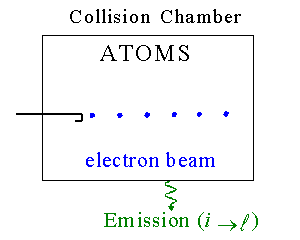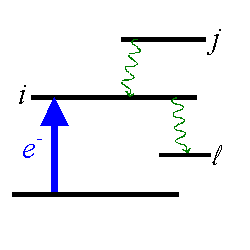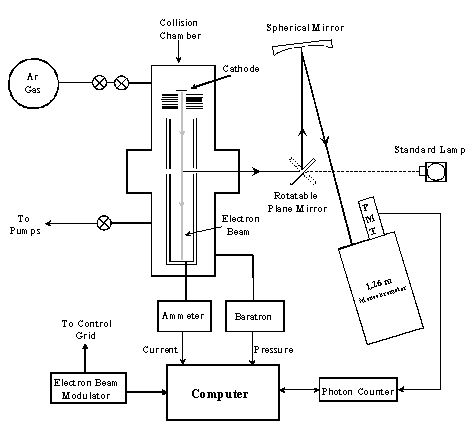II) Electron-Impact Excitation out of the ground state of Atoms

A. General
Optical Method
The majority of this Primer will focus on the measurement of cross sections using the Optical Method. To measure cross sections with the optical method, we start with a vacuum chamber that has been evacuated down to 10-7 Torr or better. The chamber is then filled with the gas of interest to a number density n. A mono-energetic electron beam is passed through the chamber. Emissions from the excited atoms pass through a window in the chamber and are detected with a suitable detector. The electron beam will excite the atoms into many upper states. Each upper state has a
probability for decaying to a number of lower states. The optical cross section is
the light intensity observed for one such decay transition divided by the target number
density and electron beam flux:
The electron beam will excite the atoms into many upper states. Each upper state has a
probability for decaying to a number of lower states. The optical cross section is
the light intensity observed for one such decay transition divided by the target number
density and electron beam flux:

If we sum the cross section over all possible decays to the lower states l, we obtain the apparent cross section for the level i. This cross section inculdes all processes for populating the upper state i. Neglecting collision transfer and other such effects, there will be two primary ways to populate state i: Direct excitation into i, and cascades from excitation into higher levels j.

The direct cross section Qidir is the most fundamental quantity. To measure it, one must find both the apparent cross section (all atoms leaving the level) as well as the optical cross sections for all atoms cascading into the level:

This leads to the measurement of direct cross section for eletron-impact excitation into level i at the given electron energy. This process must be repeated for a number of different incident-electron energies to yield an excitation function of Qi(E) versus E.
Experimental Arrangement
A sample experimental apparatus to measure cross sections using the optical method is shown below. In this example, the stainless steel collision chamber is evacuated with various vacuum pumps (diffusion pumps, ion-pumps, getter-pumps) and then filled with Argon gas. The chamber pressure is read by a Baratron capacative manometer. The electron beam is formed by an indirectly heated Barium-oxide cathode, and a number of electrostatic focusing grids. The electron current is collected by a deep Faraday Cup read by an ammeter. The wavelength for each transition is selected with the 1.26m monochromator and detected with a photomultiplier tube (PMT). Photon counting is used to subtract any background light from the signal. The efficency of the optical system is found by using a standard lamp of know spectral irradiance. The whole experiment is under computer control.

references:
Principles and Methods for Measurement of Electron Impact Excitation Cross Sections for Atoms and Molecules by Optical Techniques A. R. Filippelli, Chun C. Lin, L. W. Anderson, and J. W. McConkey, Adv. At. Mol. Opt. Phys. 33 (1994) 1-62.
 |
 |
 |